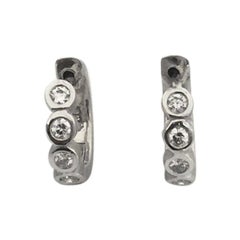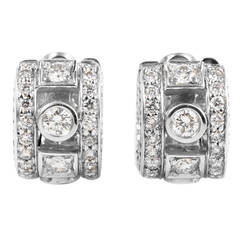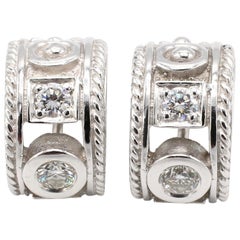Penny Preville Huggie
2010s Hoop Earrings
Recent Sales
21st Century and Contemporary Unknown Hoop Earrings
White Diamond, 18k Gold, White Gold
2010s Contemporary Hoop Earrings
Diamond, 18k Gold, White Gold
21st Century and Contemporary Hoop Earrings
Diamond, White Diamond, Gold, 18k Gold, Yellow Gold
The Legacy of Diamond in Jewelry Design
Antique diamond rings, diamond tiaras and dazzling vintage diamond earrings are on the wish lists of every lover of fine jewelry. And diamonds and diamond jewelry are primarily associated with storybook engagements and red-carpet grand entrances — indeed, this ultra-cherished gemstone has a dramatic history on its hands.
From “A Diamond Is Forever” to “Diamonds Are a Girl’s Best Friend,” pop culture has ingrained in our minds that diamonds are the most desired, the most lasting and the most valuable gemstone. But what makes the diamond so special? Each stone — whether it’s rubies, sapphires or another stone — is unique and important in its own right. April babies might claim diamonds for themselves, but just about everyone wants this kind of sparkle in their lives!
There are several factors that set diamonds apart from other stones, and these points are important to our gem education.
Diamonds are minerals. They are made up of almost entirely of carbon (carbon comprises 99.95 percent; the remainder consists of various trace elements). Diamonds are the hardest gemstones, ranking number 10 on the Mohs Hardness Scale. Even its name, diamond, is rooted in the Greek adamas, or unconquerable. The only object that can scratch a diamond is another diamond. Diamonds are formed deep within the earth at very high temperatures (1,652–2,372 degrees Fahrenheit at depths between 90 and 120 miles beneath the earth’s surface) and are carried up by volcanic activity. Diamonds are quite rare, according to the Gemological Institute of America, and only 30 percent of all the diamonds mined in the world are gem quality.
In the 1950s, the Gemological Institute of America developed the 4Cs grading system to classify diamonds: clarity, color, cut and carat weight. Not all diamonds are created equal (there are diamonds, and then there are diamonds). The value of the diamond depends on the clarity (flawless diamonds are very rare but a diamond's value decreases if there are many blemishes or inclusions), color (the less color the higher the grade), cut (how the diamond’s facets catch the light, certain cuts of diamonds show off the stone better than others) and carat weight (the bigger, the better).
When you start shopping for a diamond engagement ring, always prioritize the cut, which plays the largest role in the diamond's beauty (taking the time to clean your diamond ring at least every six months or so plays a role in maintaining said beauty). And on 1stDibs, a range of buying guides can be found for those in the market for antique engagement rings, vintage engagement rings or Art Deco engagement rings.
Shop antique and vintage diamond rings, diamond necklaces and other extraordinary diamond jewelry on 1stDibs.
Finding the Right Hoop-earrings for You
It is almost impossible to overstate how popular hoop earrings are today. They are routinely seen adorning the ears of high-profile women, ranging from Michelle Obama and Alexandria Ocasio-Cortez to Jennifer Lopez and Cardi B.
The roots of the hoop-earring phenomenon literally stretch back to the dawn of civilization. On view in the Metropolitan Museum of Art’s Ancient Near Eastern Art gallery is a pair of simple gold hoops from Mesopotamia dating to 2,600–2,500 B.C. that experts agree is among the oldest known examples. Hoop earrings can also be found in the Met’s Egyptian art gallery as well as in the museum’s displays of Greek and Roman art.
What inspired the original hoop design and why it was adopted by so many jewelers in the ancient world are unknown. It doesn’t have an origin story, feeling rather like the jewelry equivalent of the wheel. There just seems to be a logic to a circle that goes from the front to the back of the lobe.
“Hoops have been worn for millennia because they are unfathomably chic,” says Annabel Davidson, the editor of Vanity Fair UK’s special jewelry edition. “The way they accentuate the jawline, elongate the face and add a touch of flamboyance to a look is clearly a timeless expression of confidence, femininity and sartorial savvy.”
Throughout the ages, there have been countless decorative variations of hoop earrings. While the style can be found in just about every era, it was far more popular in some periods than others. Certain looks from yesteryear reflect cultural interests, while others are purely glamourous.
On 1stDibs, shop vintage diamond hoop earrings, gold hoop earrings, contemporary hoops and many more varieties of this wildly popular accessory.


